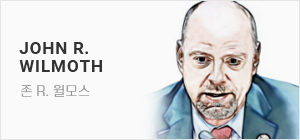| ||
| Republican presidential candidate, former U.S. President Donald Trump participates in the CNN Presidential Debate at the CNN Studios on June 27, 2024 in Atlanta, Georgia. [AFP] |

In the 1992 US presidential campaign, Bill Clinton‘s election strategist, James Carville, famously explained: “It’s the economy, stupid.” He meant that the recession the country was then experiencing was helping tip voters towards Clinton and against then-President George H. W. Bush.
The picture has reversed now. The US economy is performing strongly, more so than many others, but American voters are not inclined to give the credit to President Biden. Opinion polls slightly favour his challenger, Donald Trump. A campaign strategist today might well say, “It‘s the politics, stupid.” The American electorate is deeply divided, and the state of the economy looks unlikely to be decisive.
For in many countries in this year of elections, extremist parties seem likely to do well, and the centre is collapsing. This is very apparent in some European countries. For instance, in France, Germany and the Netherlands, centrist parties or coalitions have lost ground to the extreme right in particular. There are some counter-examples, such as the UK and India, but in general democratic politics has become far more polarised and volatile than in the past.
What are the economic implications of this political tumult? Businesses prefer moderation and stability, albeit with an inclination towards parties of the right that seek to reduce taxes. One immediate reason for this preference is that contentious politics imply policy instability, which creates a risk premium. The environment for investment is therefore less favourable. Global economic growth this year is already expected to be low, with the prospects for the next five years the weakest in decades, according to the International Monetary Fund. One major contributor to the dismal outlook is the sustained slowdown in business investment. Increasing political uncertainty will only weigh down even more on investment plans and the outlook for growth.
This reluctance on the part of investors could have significant long-term consequences. With two major technological transitions, AI and green energy, under way, investment decisions now will set the path for growth potential for decades to come. Both digital and zero carbon technologies require substantial investment―all the estimates for green transition alone are in the trillions of dollars a year, adding up to perhaps $100-$300 trillion by 2050.

The trend toward an increasing number of extreme weather events underlines the present and future costs of failing to invest in green transition technologies. But green policies have become politically contentious in many places. Extremist parties are aligning around anti-environmental positions, and their supporters are at least partly motivated by wanting not to bear extra costs for everyday necessities like heating and transport. The French ‘gilets jaunes’ movement in 2018 was an early example, motivated by opposition to increased fuel duties. The German government in 2023 had to weaken its targets to require the installation of heat pumps in housing, when the far right Alternativ für Deutschland led a political backlash against the policy. In the UK, the backlash has affected local government policies introducing lower speed limits or limitations on traffic in residential neighbourhoods. In general, public support for many environmental policies remains reasonably solid but green transition has become an issue that increasingly splits people along partisan lines. This significantly raises the uncertainty around policies, discouraging businesses from investing in relevant technologies.
| ||
| The charging station for electric vehicles is seen at the stand of Russian company Pandora during the international exhibition of energy saving, green energy and electric transport RENWEX 2024 in Moscow, Russia 18 June 2024. [EPA] |
The issues are different when it comes to investment in frontier technologies such as AI and biomedicine. Global AI investment is lower than its 2021 peak but still about $100bn last year, while investment in generative AI has rocketed. Debates about regulating AI tend to be technical and complicated. The big tech companies are lobbying intensively against stronger competition enforcement in the US and EU, arguing that anti-trust policies will inhibit their future investment; but for now, at any rate, it is not a hot button issue for the voting public. In this case, the question may be more about the types of innovation that get funded, in the context of unstable domestic politics and increasing geopolitical tension. For example, investment in AI is already heavily concentrated in the US and China. Will it tilt increasingly toward innovation in weapons systems rather than, say, domestic robotics? Defence budget purchases of AI-powered innovations may look more secure and less prone to regulatory intervention than the alternatives.
Slow growth globally is worrying for two reasons. One is that living standards for many people are stagnating, which itself can contribute to political discontent. The other is that it limits the scope governments consider there is to raise public investment spending, and limits the capacity of macroeconomic policy to respond to future economic shocks. There is a risk of a ‘doom loop’ of slow growth leading to lower revenues and budget cuts, leading to slower growth.
| ||
| A girl interacts with an artificial intelligence (AI) robot at the fourth China International Consumer Products Expo(CICPE) in Haikou, capital city of south China''s Hainan Province, April 15, 2024. [Xinhua] |
Increasing productive investment, by both public and private sectors, is a priority for governments everywhere. This is a structural as well as a cyclical phenomenon. There is a need for a short-term recovery after the recent inflation shock. But more importantly, the fact of the twin technological transformations, in energy and in AI, means there is a window of opportunity to shape decisively an economy‘s long-term comparative advantage and growth prospects. In both areas of technology, the identity of the winners and losers will be determined in the next few years.
History doesn‘t repeat itself, but it rhymes: the combination of substantial technological transitions and unstable political environments is reminiscent of the 1920s, when the spread of electricity use and the new media of radio and telephone were reshaping industries and changing the information environment. That was certainly not a stable period for the world economy, even though it eventually paved the way for higher productivity and living standards. Will governments be able to take such a strategic view, and create sufficient national consensus across partisan lines, for the kind of market-shaping needed now? The answer varies a great deal in different countries, but in some obvious cases the extent of polarisation and voter discontent makes it seem unlikely.


“바보야, 문제는 정치야”
1992년 미국 대선 캠페인 당시 빌 클린턴의 선거 전략가였던 제임스 카빌이 남긴 유명한 표현이 있다. “바보야, 문제는 경제야(It’s the economy, stupid)”. 그는 당시 미국에 불어닥친 불황이 유권자들을 조지 H. W. 부시 대통령이 아닌 클린턴 쪽으로 기울게 도와주기를 바랐던 것이다.
지금은 상황이 역전됐다. 미국 경제는 다른 많은 나라에 비해 훨씬 탄탄하지만, 미국 유권자들은 그 공을 바이든 대통령에게 돌리려 하지 않는다. 여론조사에서는 그에 맞선 도전자 도널드 트럼프가 살짝 앞선다. 지금의 캠페인 전략가라면 아마 “바보야, 문제는 정치야(It’s the politics, stupid)”라고 말할 것이다. 미국 유권자들은 깊이 분열돼 있고, 경제 상황이 결정적인 변수가 될 가능성은 작아 보인다.
선거의 해인 올해 많은 나라에서 극단주의 정당이 선전할 것으로 보이는 한편, 중도는 무너지고 있다. 이 현상은 일부 유럽 국가에서 특히 두드러진다. 예를 들어 프랑스나 독일, 네덜란드의 경우 중도 성향의 정당이나 연합이 특히 극우에 밀려나고 말았다. 영국이나 인도처럼 이와 반대되는 사례도 조금 있지만, 전반적으로 민주주의 정치는 그 어느 때보다 양극화하고 불안해졌다.

이 정치적 혼란이 경제에 미치는 영향은 무엇일까. 기업들은 감세를 추구하는 우파 정당을 지지하는 경향이 있긴 해도 온건과 안정을 선호한다. 그 직접적인 이유 중 하나는 정치에서 정쟁이 잦으면 정책이 불안정해짐을 뜻하고, 이것은 ‘위험 프리미엄(risk premium)’을 발생시키기 때문이다. 따라서 투자 환경이 불리해진다.
국제통화기금(IMF)에 따르면 올해 세계 경제성장은 이미 낮을 것으로 예측되며, 앞으로 5년은 수십 년만에 가장 약할 것으로 관측된다. 이 우울한 전망을 만든 큰 요인 중 하나는 사업투자의 지속적인 둔화다. 정치적 불확실성의 확대는 투자 계획과 성장 전망을 더욱 짓누를 것이다.
이런 투자자 측면의 망설임은 상당한 장기적 결과를 낳을 수 있다. 인공지능(AI)과 녹색 에너지라는 양대 기술 전환이 진행 중인 상황에서 지금의 투자 결정이 앞으로 수십 년 간의 성장 잠재력을 좌우할 것이다. 디지털과 탄소 제로(Zero carbon) 기술에는 모두 막대한 투자가 필요하다. 녹색 전환 관련 추정치 하나만 보더라도 연간 수조 달러, 2050년까지 총 100조~300조 달러 정도에 육박한다.
기상 이변이 증가하는 추세를 보면 녹색 전환 기술에 투자하지 않을 경우 현재와 미래에 어떤 비용을 치르게 될지 분명히 알 수 있다. 그러나 녹색 정책은 곳곳에서 정치적 논쟁거리가 돼 버렸다. 극단주의 정당들은 반(反)환경주의로 오와 열을 맞추고 있으며, 그 지지자들의 지지 이유에도 최소한 어느 정도는 난방과 운송 같은 생활필수품에 추가 비용을 지불하고 싶지 않다는 마음이 깔려 있다. 2018년에 있었던 프랑스의 ‘노란 조끼(Gilets Jaunes)’ 운동은 유류세 인상에 반대해 일어난 초기 사례라고 할 수 있다. 2023년, 독일 정부는 주택 내 히트펌프 설치 의무화 목표를 완화해야 했다. 극우 정당인 독일을 위한 대안(AfD)이 이 정책에 정치적 반발을 주도한 탓이다.

영국에서는 제한속도 하향이나 주택가 통행 제한을 도입하는 내용의 지방정부 정책이 이런 반발의 영향을 받았다. 전반적으로는, 여러 환경 정책에 대해 아직은 대중의 지지가 합리적으로 견고하지만, 녹색 전환은 갈수록 당파에 따라 국민들을 분열시키는 쟁점이 되고 말았다. 이런 현상은 정책을 둘러싼 불확실성을 키우고, 관련 기술에 대한 기업의 투자를 위축시킨다.
AI, 생의학과 같은 첨단 기술에 대한 투자의 경우 문제가 다르다. 전 세계 AI 투자는 2021년에 정점을 찍은 후 줄어들었지만, 여전히 작년 기준 약 1000억 달러에 이르며 생성형 AI에 대한 투자는 급증했다. AI 규제에 관한 논의는 보통 기술적이고 복잡하다. 빅테크 기업들은 반독점 정책이 자신들의 미래 투자를 억누를 것이라면서 미국과 EU의 경쟁법 집행 강화에 대응해 집중적인 로비를 펼치고 있다. 어쨌거나 당분간은 유권자들에게 뜨거운 쟁점은 아니다. 이런 경우, 국내 정치가 불안정하고 지정학적 긴장이 고조되는 상황에서 어떤 종류의 혁신이 자금을 확보하는지가 더 큰 문제가 될 수 있다.
예를 들면, AI에 대한 투자는 이미 미국과 중국에 심하게 편중돼 있다. 이것이 국내 로봇공학 같은 것 대신 무기체계의 혁신 쪽으로 점차 기울어질까. 방위예산을 이용한 AI 기반의 혁신품 구매가 다른 대안들에 비해 더 안전하고 규제적 개입에서 좀 더 자유로워 보일 수도 있다.

전 세계적으로 더딘 성장이 걱정스러운 이유에는 두 가지가 있다. 하나는 많은 사람들의 생활 수준이 정체되고 있고, 그 자체만으로 정치적 불만을 부채질할 수 있다는 것이다. 다른 하나는 이것이 정부가 생각하는 공공 투자 지출의 확대 범위를 한정 짓고 미래의 경제적 충격에 대비하는 거시경제 정책의 능력을 제한한다는 것이다. 더딘 성장이 수익 하락과 예산 삭감으로, 그리고 다시 더 더딘 성장으로 이어지는 ‘둠 루프(Doom Loop·파멸의 고리)’에 빠질 위험이 있다.
공공과 민간 부문 모두에 의한 생산성 투자의 확대는 어느 정부에나 우선순위다. 이것은 구조적이며 주기적인 현상이다. 최근의 인플레이션 충격 이후 단기적인 회복이 필요하다. 그러나 더 중요한 것은 에너지와 AI의 양대 기술 혁신은 경제의 장기적 비교우위와 성장 전망에 결정적인 영향을 미칠 기회의 창이 존재함을 뜻한다. 이 두 기술 영역 모두, 누가 승자와 패자가 될지는 앞으로 몇 년 안에 판가름 날 것이다.
역사는 반복되는 것이 아니라 변주된다. 상당한 기술적 전환과 불안정한 정치 환경의 만남은 전기 사용의 보급과 라디오, TV라는 새로운 미디어가 산업을 바꾸고 정보 환경을 변모시켰던 1920년대를 떠오르게 한다. 그 기간은 궁극적으로 생산성과 생활 수준의 향상으로 이어졌지만 세계 경제에 있어 결코 안정적인 시기는 아니었다. 각국 정부가 그런 전략적 관점을 가지고 지금 필요한 형태의 시장 조성을 위해 당파를 초월한 범국가적 합의를 충분히 끌어 낼 수 있을까. 답은 나라마다 천차만별이지만, 양극화와 유권자들의 불만이 어느 정도인지에 따라 그 가망성이 희박해 보이는 경우도 분명히 존재한다.
hongi@heraldcorp.com














